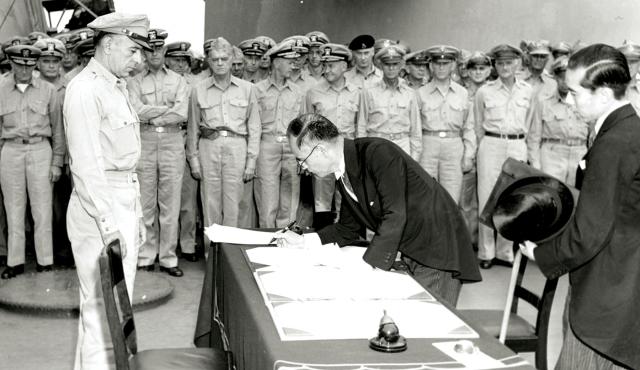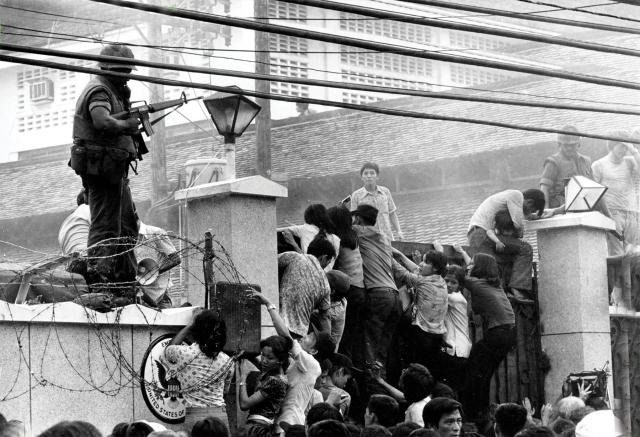Colonel Thomas C. Greenwood

Fighting terrorists and insurgents for two decades has made it difficult for the U.S. military to transition from thinking about regional “wars amongst the people” to potential conflict between major nuclear powers.1 This challenge is exacerbated by fading Cold War memories and having to cope with COVID-19 at the same time U.S. global supremacy is being challenged by China and, to a lesser degree, Russia. Managing these competitors in a way that preserves American hegemony while avoiding conflict—the “Thucydides Trap” that befell Sparta and Athens during the Peloponnesian War—will not be easy.2
The narrative that national security professionals use to discuss warfare in the second nuclear age opens a window into the richness of strategic thinking about deterrence, escalation, and war termination. Thus, the continued focus at U.S. war colleges and combatant commands on designing a theory of victory to defeat great power adversaries seems ill-suited for big wars in the 21st century. Conceptualizing war in terms of winners and losers, rather than achievement of more modest political objectives, risks strategic overreach and ignores warfare’s historical trend toward gray inconclusiveness.3

The surrender of Japan on board the USS Missouri (BB-63) in Tokyo Bay on 2 September 1945 established in the public a notion of total victory that is unhelpful in planning for wars in the nuclear age. Credit: Naval History and Heritage Command
Moreover, emotional terms such as victory and defeat can distract strategists and Pentagon planners from grappling with the complexities of war between nuclear adversaries: why it might occur, how it should be fought, and for what ends. The wrong mental model—nostalgic images reminiscent of the iconic 1945 surrender ceremony on board the USS Missouri (BB-63)—can create false expectations and undermine popular support when use of force proves necessary. In short, victory and defeat trivialize why nations seek to limit war and strive to ensure that conventional conflicts do not escalate into nuclear conflagrations.
War termination is not a new theme. In his 1971 classic, Every War Must End, former Under Secretary of Defense Fred Iklé argued persuasively that more thought goes into starting wars than ending them. And when the end does come, it typically involves reaching agreement with former enemies over an admixture of ceasefires, negotiated settlements, territorial concessions, prisoner negotiations and repatriations, unilateral withdrawals, and the like. In short: “To bring fighting to an end, one nation or the other almost always has to revise its war aims.”4 Not surprisingly, the cost to the victor frequently determines the severity of the postwar environment.
Iklé’s views rest firmly on Clausewitz’s dicta that all wars are fought for political purposes and military force is a policy instrument that civilian leaders select to achieve postwar objectives. Yet, the U.S. armed forces are more often used for humanitarian relief, peacekeeping operations, forward presence, state-building, promoting democracy, counterinsurgency, and counterterrorism than fighting existential threats requiring an adversary’s unconditional surrender. At least for now, wars of annihilation have become the exception rather than the rule. This is a positive development for mankind and may explain why nuclear weapons use is anathema. Nonetheless, discussion of war termination beyond a simplistic construct of winners and losers has failed to gain traction. There are a number of possible reasons why this is so, and several things can be done about it.
What Are We Fighting For?
One of war’s many paradoxes is that nations cannot achieve postwar objectives if their armed forces make a habit of losing battles and campaigns; however, winning them does not automatically translate into strategic success. The more protracted a conflict becomes, the easier it is to focus on the clash of opposing forces instead of the political objectives, or ends, for which the conflict is being waged. As former Foreign Affairs editor Gideon Rose puts it: “Leaders and publics have usually gotten so caught up in beating the enemy that they find it hard to switch gears and think clearly about constructing a desirable and stable political settlement. So they rarely handle the endgame challenges well and usually find themselves at the mercy of events rather than in control of them.”5
As casualties and costs mount, senior leaders quite rightly reassess the value of the object for which they are fighting. Unfortunately, the metrics they use are often tactical in nature and focus on the number of enemy troops killed, bombs dropped, and cities captured instead of on other substantive prerequisites and strategic enablers necessary to achieve their political goals. The body count in Vietnam received more attention than the legitimacy and effectiveness of Saigon’s central government. In the second Iraq War, postconflict stabilization was an afterthought compared to how rapidly coalition forces liberated Baghdad. As strategist Colin Gray pithily observed, “Military action is initiated not for its military effect, which must be trivial in scale and inherent significance, but rather for its psychological and hence political consequences.”6 Thus, ensuring military action remains strategically intentional will present a perennial challenge.
Keep the Gloves On
Donald Stoker, a former Naval Postgraduate School professor, argues that U.S. wars might end more favorably if less attention was given to limiting the means (application of force) and more was paid to crafting the ends for which America’s sons and daughters fight and die. Perhaps. But Stoker’s proposition that limited wars might be terminated more quickly and decisively using unlimited means is flawed for three reasons.7
First, using unlimited means to wage counterinsurgencies and gray zone conflicts (i.e., hybrid wars)—the preponderance of wars the United States has fought since Vietnam—risks employing excessive force and harming the civilian populations the U.S. and host-nation security forces must protect to succeed.
Second, U.S. legitimacy and credibility with the international community require the United States to apply lethal force in a proportional manner that adheres to the normative strictures of the laws of armed conflict, which guide battlefield behavior. Aerial bombing that fails to distinguish between combatants and noncombatants and excessive destruction of civilian infrastructure (beyond the parameters of “military necessity”) is morally wrong and harmful to U.S. interests.8 Unquestionably, China and Russia will exploit lapses in U.S. battlefield behavior to paint the United States as an evil aggressor in pursuit of imperial aims. In short, to succeed in limited wars, restraint must be applied to both means and ends.
Third, implicit in the unlimited means argument is the notion that insufficient combat power is the principal reason the United States failed to achieve its policy objectives in Iraq and Afghanistan. This is untrue: Troop surges during both wars had short-term, positive impacts on tactical operations but did not alter either outcome, notwithstanding the United States’ overwhelming technological advantage. Causal factors beyond the number of “boots on the ground” proved more decisive in shaping the end game. As political science professor Jeffrey Meiser notes: “A casual observer of American strategic discourse over the past decade and a half could be excused for thinking strategy is simply a debate about how many troops should be deployed for combat operations. This approach misses the core function of strategy, which is to figure out what to do with those boots on the ground.”9
Deterrence Dynamics
Today’s policymakers face three geostrategic imperatives: to avoid a major conventional war with China and Russia; to identify opportunities to cease hostilities while preserving U.S. national interests should conflict occur (frequently called “off-ramps”); and, most important, to reduce potential catalysts for escalation that could motivate adversaries to cross the nuclear threshold first.10 Theory-of-victory hyperbole clashes with all three by presenting a zero-sum approach for trying to prevent war and limiting escalation after conflict breaks out. Victory rhetoric also reflects a general disregard for nuclear deterrence dynamics.
Nations acquire nuclear weapons to protect themselves against regime change and existential defeat.11 Retaining second- (and possibly third-) strike nuclear response options means any adversary foolish enough to violate the nuclear taboo must be prepared to suffer devastating nuclear counterattacks. Mutually assured destruction restrains nuclear adversaries and has made deterrence by denial both credible and effective for more than 75 years. (That deterrence theory may be eroding is a different issue.12)
Advocates of brinkmanship and controlling escalation by fighting a limited nuclear war (i.e., embracing a “cost-imposition strategy” that seeks to punish an enemy with increasing levels of pain) overlook the primary incentive that dissuades great powers from crossing the nuclear threshold in the first place—confidence they can achieve an acceptable outcome to an ongoing conventional conflict without using weapons of mass destruction.13 The less favorable the outcome to one party, the more that side will be incentivized to cross the nuclear threshold.14 Signaling an intent to “double down” and “win” pushes deterrence dynamics in an unhelpful direction, which could inadvertently escalate a conflict. This is especially true if adversaries fear the United States is on the cusp of initiating conventional strikes to destroy their nuclear command-and-control systems and second-strike retaliatory capabilities. In short, this approach could trigger a “use it or lose it” mentality that spirals out of control.15

The chaos of the evacuation of Afghanistan evoked memories of the fall of Saigon in April 1975. Former Under Secretary of Defense Fred Iklé argued persuasively in 1971 that more thought goes into starting wars than ending them. In retrospect, Iklé used considerable understatement when he wrote: “To bring fighting to an end, one nation or the other almost always has to revise its war aims.” Credit: Associated Press (Neal Ulevich)
The emergence of dual-capability weapon systems (armed with conventional or nuclear warheads) and the continued improvement of conventional missile technology, especially highly maneuverable hypersonics, will make it more difficult to identify the nature of incoming attacks.16 This increases the risk decision-makers could misconstrue a conventional attack for a nuclear strike. It also explains why any future conventional war between major powers will naturally become a “competition over the limits of violence,” as both sides race to convince each other of their commitment to avoid escalation and find an off-ramp.17
The March to Success
Navy Captain Mark Morris has argued that strategists must have a “scenario story that describes a possible path to victory. Such a story is not an attempt to predict the future but rather some plausible explanation of what could happen.”18 The problem with this argument is that, in a big war between nuclear adversaries, for one side to prevail and “win” in a classical sense the threat or use of nuclear weapons is a virtual given. This hidden assumption about nuclear escalation is problematic. Moreover, when strategists do invent a scenario story, it is often heavily biased in favor of U.S. forces, exaggerating their positive impact and—most damning of all—underestimating adversaries’ ability to deny the United States its war objectives.
In his book detailing five U.S.-sponsored Middle East regime changes from 1953 to 2011, former assistant secretary of state Philip Gordon describes a storyline process in which multiple administrations repeatedly assumed new foreign regimes would be friendlier to the United States than the ones deposed. However, as Gordon documents, the flimsy knowledge policymakers had of the diverse range of political actors who could potentially take the reins of power made this a fatally flawed assumption.19 Wishful thinking replaced sober-minded cost-benefit analysis.
Recognizing that current and future wars cannot be accurately described by labeling adversaries as winners and losers has prompted Jeffrey Meiser to advocate for a theory-of-success framework, which “encourages creative thinking while keeping the strategist rooted in the process of causal analysis; it brings assumptions to light and forces strategists to clarify exactly how they plan to cause the desired end state to occur.” Of course, at the heart of any strategy are the explicit and implicit assumptions planners adopt—but too often fail to verify and validate. Meiser contends that, by articulating a theory of success, strategists will be inspired to think more seriously about how resources are used—the actions (ways) to undertake—rather than simply focusing on the available resources (means). In the process, he thinks, this approach will motivate planners to develop “rival theories of success” and help decision-makers discover and leverage new sources of power.20
Use the F-Word
A theory of success provides planners with a more practical, flexible, and modest framework for contemplating big war in the nuclear age than linear road maps, which promise victory in a wide range of military undertakings with differing operational contexts. Yet, while developing a theory of success will likely be a useful part of the military planning process, it will be insufficient—unless it is complemented with the F-word: Failure.
Assessing how a military plan can fail to achieve the desired and often murky political end state gives planners a feedback loop that can help strengthen the plan before it is approved and implemented. The loop works in two ways. First, for every major possible cause of failure planners identify, they can attempt to devise a remedy or mitigation. Next, planners can assign levels of risk to help senior political and military leaders decide which course of action or operational plan has the most promise to succeed.
Thinking about failure has inspired research psychologist Gary Klein to implement “Project Pre-Mortem,” which encourages corporate and military leaders to subject finished plans to failure thinking.21 Instead of asking what might go wrong, the premortem assumes the plan has failed catastrophically, and team members must describe why. After running dozens of premortem events, Klein is convinced this analytical tool helps a plan avoid falling victim to groupthink, overinvested advocates, untested hypotheses, hidden assumptions, voiceless stakeholders, domineering bosses, and the tendency for bureaucracies to assume plans will magically implement themselves.22
Achieving Strategic Coherence
Historian Michael Howard argues that the West persuaded the Soviet Union it would lose the Cold War, not by defeat in a traditional sense, but by “a nuclear catastrophe in which such terms as ‘defeat’ and ‘victory’ were irrelevant.”23 Today, adopting a new lexicon that focuses on success instead of victory will help planners more carefully define the ends, ways, and means they will use to limit conflicts. This approach should spawn a deeper appreciation across the national security community for the stark differences between fighting nonstate actors—who thus far have posed no existential threat to the U.S. homeland—and nuclear-armed adversaries capable of generating apocalyptic effects at almost any time and place.
British military historian Hew Strachan reminds us that Clausewitz believed the ultimate purpose of war was for peace. . . . The aim was to create a military situation sufficiently favorable to give relative advantage in the negotiation of peace. The destruction of the enemy’s armed forces or the seizure of his territory were not the aims of the war but the means to opening the door to its cessation.24
U.S. military schools, diplomatic training courses, and midcareer executive education programs should continue to educate national security professionals about the adverse consequences of conflating means and ways with political ends. More important, the war aims (political objectives) the U.S. armed forces seek to accomplish using force must be crafted with a clarity that can come only from a thorough grasp of history, a mastery of critical-thinking skills, and lengthy public service careers that require engagement in constructive civil-military discourse—in which strategic wisdom is valued at least as much as tactical finesse and battlefield prowess.
No comments:
Post a Comment